From the Times' Opinion section for some reason or other:
Word for Word | Viagra
Recalling the Madness
By CHRIS CONWAY
Published: March 30, 2008
Ten years after Viagra hit the market, revisiting some of The Times’s reporting on the drug’s first months.
Personally I think it needs a few more years before it's really history though...
An unofficial blog about the National Museum of Health and Medicine (nee the Army Medical Museum) in Silver Spring, MD. Visit for news about the museum, new projects, musing on the history of medicine and neat pictures.
Monday, March 31, 2008
Sunday, March 30, 2008
New Mary Roach book
Mary Roach has stopped by the Museum and written about it iirc, in Stiff. She's got a new book out, Bonk, on sex which the New York Times reviewed and she can be heard on the Times' podcast too.
Library of Congress' new AV facility
This article, "Projecting the Future Needs of Preservation," By Adam Bernstein, Washington Post Staff Writer, Sunday, March 30, 2008; Page M14, is an interesting look at the Library of Congress' new AV facility. Of course, there are millions of films and records (I'd guess) that the LoC doesn't have and that the rest of us don't have the time nor money to preserve. At the Museum, we transferred our World War 2 propaganda films to the Library about a decade and a half ago - they weren't medical, and people would get better use of them at the Library. However, we kept a couple of thousand medical ones, which were reinforced by a couple of thousand videotapes from Walter Reed's tv branch (aka WRAMC-TV), and then with another 4000 from the Walter Reed Army Institute of Research's (WRAIR) collection. The ones from WRAIR are particularly interesting as they had teams of sixty people in Vietnam during the war. So now the Museum's sitting on about 8000 films and videos. We mounted a partial-finding aid on the web earlier this year which ended up being fifteen pages anyway, but can't play most of this material so users have to pay for duplication at the beginning.
the week in flickr
Last week's pictures posted on flickr -
March 28th:
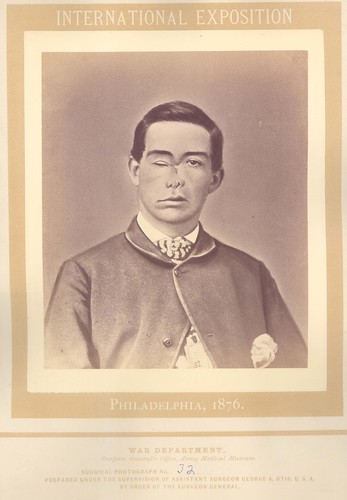 "Shell Wound of Face." Pvt. William H. Nims, Co. D, 61st New York Volunteers, wounded at Petersburg, VA.
"Shell Wound of Face." Pvt. William H. Nims, Co. D, 61st New York Volunteers, wounded at Petersburg, VA.
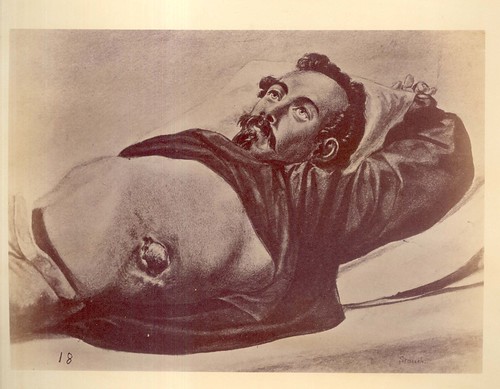 "Penetrating gunshot would of the thorax and abdomen. A round musket ball having entered the left pleural cavity, passed through the diaphragm, and thence into some part of the intestinal canal. Recovery." Capt. Robert Stolpe, Co. A, 29th New York, wounded at battle of Chancellorsville, May 2, 1863. Artwork by E. Stauch.
"Penetrating gunshot would of the thorax and abdomen. A round musket ball having entered the left pleural cavity, passed through the diaphragm, and thence into some part of the intestinal canal. Recovery." Capt. Robert Stolpe, Co. A, 29th New York, wounded at battle of Chancellorsville, May 2, 1863. Artwork by E. Stauch.
 "Doing Cure in Kiosk, 16* below Zero." A free tuberculosis clinic in White Haven, Pennsylvania. Probably early 20th century.
"Doing Cure in Kiosk, 16* below Zero." A free tuberculosis clinic in White Haven, Pennsylvania. Probably early 20th century.
March 27th:
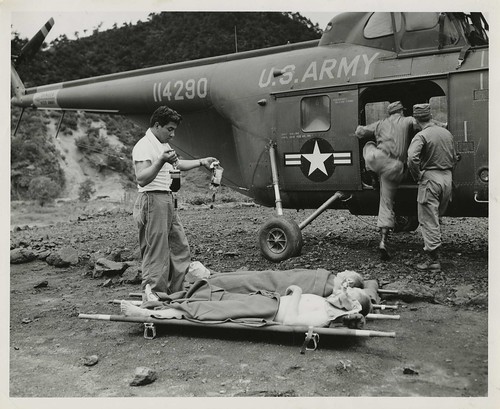 Unloading wounded from helicopter. Attendant holds IV [intravenous therapy] for patients. [First aid. Stretchers. Transfusions. Transport of sick and wounded.] Korean War. Photo from Walter Reed Army Institute of Research.
Unloading wounded from helicopter. Attendant holds IV [intravenous therapy] for patients. [First aid. Stretchers. Transfusions. Transport of sick and wounded.] Korean War. Photo from Walter Reed Army Institute of Research.
 The operation of a new litter designed to be attached to Bell helicopters used in air evacuation of the wounded from the front lines. The litter was designed by Captain Sebourn. [Transport of sick and wounded. Evacuations. Aircraft.] Korean War.
The operation of a new litter designed to be attached to Bell helicopters used in air evacuation of the wounded from the front lines. The litter was designed by Captain Sebourn. [Transport of sick and wounded. Evacuations. Aircraft.] Korean War.
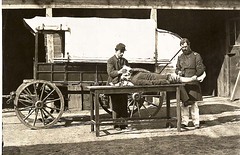 "Army Medical Wagon"
"Army Medical Wagon"
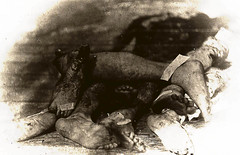 "Field Day". Amputations at Harewood Hospital in Washington, DC. Photograph from Reed Bontecou.
"Field Day". Amputations at Harewood Hospital in Washington, DC. Photograph from Reed Bontecou.
March 25th:
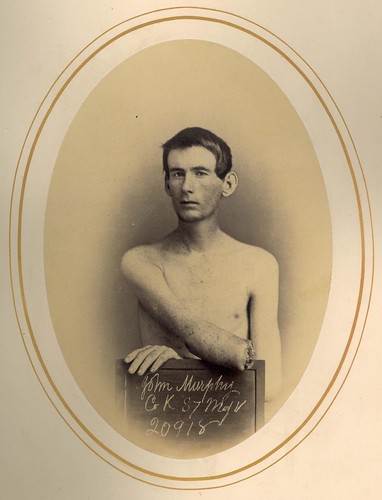 "Amputation of Forearm". Pvt. John Murphy, Co. K, 37 Massachusetts Volunteers. Wounded at Battle of Harper's Farm, VA on April 6, 1865. Treated by Dr. Reed Bontecou at Harewood Hospital, Washington, DC who had the photograph taken.
"Amputation of Forearm". Pvt. John Murphy, Co. K, 37 Massachusetts Volunteers. Wounded at Battle of Harper's Farm, VA on April 6, 1865. Treated by Dr. Reed Bontecou at Harewood Hospital, Washington, DC who had the photograph taken.
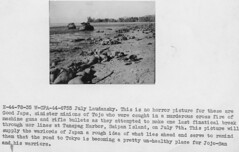 "This is no horror picture for these are Good Japs, sinister minions of Tojo who were caught in a murderous cross fire of machine guns and rifle bullets as they attempted to make one last [fanatical] break through [our] lines at Tanapag Harbor, Saipan Island, on July 7th. This picture will supply the warlords of Japan a rough idea of what lies ahead and serve to remind them that the road to Tokyo is becoming a pretty un-healthy place for Tojo-san and his warriors." W-CPA-44-6755 July Laudansky. World War 2. 10/1/1944.
"This is no horror picture for these are Good Japs, sinister minions of Tojo who were caught in a murderous cross fire of machine guns and rifle bullets as they attempted to make one last [fanatical] break through [our] lines at Tanapag Harbor, Saipan Island, on July 7th. This picture will supply the warlords of Japan a rough idea of what lies ahead and serve to remind them that the road to Tokyo is becoming a pretty un-healthy place for Tojo-san and his warriors." W-CPA-44-6755 July Laudansky. World War 2. 10/1/1944.
See a discussion of this picture and caption.
March 28th:
 "Shell Wound of Face." Pvt. William H. Nims, Co. D, 61st New York Volunteers, wounded at Petersburg, VA.
"Shell Wound of Face." Pvt. William H. Nims, Co. D, 61st New York Volunteers, wounded at Petersburg, VA. "Penetrating gunshot would of the thorax and abdomen. A round musket ball having entered the left pleural cavity, passed through the diaphragm, and thence into some part of the intestinal canal. Recovery." Capt. Robert Stolpe, Co. A, 29th New York, wounded at battle of Chancellorsville, May 2, 1863. Artwork by E. Stauch.
"Penetrating gunshot would of the thorax and abdomen. A round musket ball having entered the left pleural cavity, passed through the diaphragm, and thence into some part of the intestinal canal. Recovery." Capt. Robert Stolpe, Co. A, 29th New York, wounded at battle of Chancellorsville, May 2, 1863. Artwork by E. Stauch. "Doing Cure in Kiosk, 16* below Zero." A free tuberculosis clinic in White Haven, Pennsylvania. Probably early 20th century.
"Doing Cure in Kiosk, 16* below Zero." A free tuberculosis clinic in White Haven, Pennsylvania. Probably early 20th century. March 27th:
 Unloading wounded from helicopter. Attendant holds IV [intravenous therapy] for patients. [First aid. Stretchers. Transfusions. Transport of sick and wounded.] Korean War. Photo from Walter Reed Army Institute of Research.
Unloading wounded from helicopter. Attendant holds IV [intravenous therapy] for patients. [First aid. Stretchers. Transfusions. Transport of sick and wounded.] Korean War. Photo from Walter Reed Army Institute of Research. The operation of a new litter designed to be attached to Bell helicopters used in air evacuation of the wounded from the front lines. The litter was designed by Captain Sebourn. [Transport of sick and wounded. Evacuations. Aircraft.] Korean War.
The operation of a new litter designed to be attached to Bell helicopters used in air evacuation of the wounded from the front lines. The litter was designed by Captain Sebourn. [Transport of sick and wounded. Evacuations. Aircraft.] Korean War. "Army Medical Wagon"
"Army Medical Wagon" "Field Day". Amputations at Harewood Hospital in Washington, DC. Photograph from Reed Bontecou.
"Field Day". Amputations at Harewood Hospital in Washington, DC. Photograph from Reed Bontecou.March 25th:
 "Amputation of Forearm". Pvt. John Murphy, Co. K, 37 Massachusetts Volunteers. Wounded at Battle of Harper's Farm, VA on April 6, 1865. Treated by Dr. Reed Bontecou at Harewood Hospital, Washington, DC who had the photograph taken.
"Amputation of Forearm". Pvt. John Murphy, Co. K, 37 Massachusetts Volunteers. Wounded at Battle of Harper's Farm, VA on April 6, 1865. Treated by Dr. Reed Bontecou at Harewood Hospital, Washington, DC who had the photograph taken. "This is no horror picture for these are Good Japs, sinister minions of Tojo who were caught in a murderous cross fire of machine guns and rifle bullets as they attempted to make one last [fanatical] break through [our] lines at Tanapag Harbor, Saipan Island, on July 7th. This picture will supply the warlords of Japan a rough idea of what lies ahead and serve to remind them that the road to Tokyo is becoming a pretty un-healthy place for Tojo-san and his warriors." W-CPA-44-6755 July Laudansky. World War 2. 10/1/1944.
"This is no horror picture for these are Good Japs, sinister minions of Tojo who were caught in a murderous cross fire of machine guns and rifle bullets as they attempted to make one last [fanatical] break through [our] lines at Tanapag Harbor, Saipan Island, on July 7th. This picture will supply the warlords of Japan a rough idea of what lies ahead and serve to remind them that the road to Tokyo is becoming a pretty un-healthy place for Tojo-san and his warriors." W-CPA-44-6755 July Laudansky. World War 2. 10/1/1944. See a discussion of this picture and caption.
Friday, March 28, 2008
Netherlands health museum amusement park
Check it out at "Bounce across a rubber tongue at Corpus," Associated Press March 27 2008. There have been similar places in the US over the years, including a walk-through heart at the Franklin Museum in Philadelphia. I'm sure more suggestions can be gathered in the comments.
Our latest upload to the Internet Archive

This week we scanned and uploaded another item to the Internet Archive. It's a small booklet published during World War 1 by the War Department, Commission on Training Camp Activities and is called When You Go Home - take this book with you. It advises the troops against risky behavior with loose women and thereby avoiding venereal diseases that puts their country at risk and takes them away from the fight.
Labels:
venereal disease,
War Department,
World War 1
Thursday, March 27, 2008
Pushing our pictures
Here's some stats from the morning for our ongoing Flickr experiment in Otis Historical Archives - we've got 3 free accounts -
1 - 40831
2 - 20428
3 - 8657
69916!
The web is working for us in getting our material out to new viewers. We've asked to join Flickr's Commons, but haven't heard back yet, but stay tuned for more Flickr news.
1 - 40831
2 - 20428
3 - 8657
69916!
The web is working for us in getting our material out to new viewers. We've asked to join Flickr's Commons, but haven't heard back yet, but stay tuned for more Flickr news.
Leprosy exhibit opens at museum...
...In coordination with the new PBS film Triumph at Carville (which I saw an earlier preview of and enjoyed a lot). John Wilhelm and Sally Squires did a good job telling the history of Hansen's Disease (the now-preferred term) sufferers and the isolation they were forced into in Carville, Louisiana. Information specifically on the exhibit should eventually be on the Museum's website.
Wednesday, March 26, 2008
Women's History Month Program at NMHM

Today Tom Goehner, Manager of Historical Outreach at the American Red Cross Headquarters gave a slide presentation about the role of women in the ARC--Clara Barton, Jane Delano, Minnie Pearle, Marlee Matlin, Liddy Dole, etc. The program included some great images including this one of the ARC Gray Ladies at Walter Reed Hospital (ca. 1918). The Gray Lady service began at Walter Reed in 1918. Their uniform consisted of a gray dress and veil. They served as hostesses and provided recreational services for the recovering wounded at Walter Reed. The soldiers affectionately called them "Gray Ladies" and the name stuck. The Gray Lady service continued to serve hospital patients until the 1960s.
Evidently the ARC Archives has some 30,000 images in its collections.
Get Your Links Here
A few links that have been piling up the last few days:
- DC Confidential posted another blog about the Museum! Read it. (Thanks, DC Confidential!)
- Medgadget posted on two interesting topics: Using Mirrors to Treat Phantom Pain, and Accu-Circ for a Safer, Happier Bris. The latter is linked to, well, because I couldn't resist. The image of the device and its intended use... The first link seemed relevant as Museum staff often get a chance to interact with wounded and recovering servicemembers in and around the Museum on the campus at Walter Reed Army Medical Center.
- Street Anatomy links to a new blog called Revealed, about scientific and medical illustration.
- Information technology challenges are part of the price of doing business in today's rapidly evolving tech environment, and we're certainly not unused to dealing with those sorts of challenges on a daily basis. Musematic posted a few bullets from a Wall Street Journal story that illustrated some interesting parallels.
- And PreservationNation, a blog from the National Trust for Historic Preservation, offers an update on the Army's progress with repairing, or not, the Tomb of the Unknown Soldiers at Arlington National Cemetery.
Tuesday, March 25, 2008
Graduate Student Symposium 2 May 2008
LIVE FROM THE Washington Society for the History of Medicine, History of Medicine Division, National Library of Medicine, and the Office of NIH History, National Institutes of Health:
Graduate Student Symposium 2 May 2008
8:30 am - 5:00 pm
FREE to REGISTRANTS
Lister Hill Visitors Center
National Library of Medicine
8600 Rockville Pike, Bldg. 38A
Lunch, refreshments, snacks provided.
Registration: email Judy Chelnick chelnickj@si.edu
NIH directions, access: www.nlm.nih.gov/about/visitor.html
Plenary speaker
Angela N.H. Creager
Department of History
Program in the History of Science
Princeton University
PROGRAM
8.30-9.00 Coffee
9.00 -9.15 Introductions
David Cantor, President, Washington Society for the History of Medicine.
Elizabeth Fee, Chief, History of Medicine Division, National Library of Medicine.
Robert Martensen, Chief, Office of NIH History, National Institutes of Health.
9.15-10.15 Plenary
Angela N.H. Creager, Dept of History & Program in the History of Science, Princeton University.
Artificial Radioisotopes in Biomedicine, 1935-1955: From Gift Exchange to Commodification in the Atomic Age.
10.15–10.30 Coffee
10.30-12.15 What we’re working on. Why we’re interested. How things have changed since the last Graduate Student Symposium
A chance for all of us, graduate students and historians working in the field, to talk informally about our research projects, interests, theoretical frames, methods, etc.
Format: 5-10 minutes per participant (including discussion).
Up to 3 slides on memory stick allowed.
12.15-1.15 Lunch
1.15-2.45 Publishing Your Research
What do publishers/journals want? What not to do. How to write a good book proposal.
Mary E. Fissell, Editor, Bulletin of the History of Medicine.
Randall M. Packard, Editor, Bulletin of the History of Medicine.
Jacqueline Wehmueller, Executive Editor, the Johns Hopkins University Press.
Robert Martensen, Chief, Office of NIH History, National Institutes of Health.
2.45-3.15 Coffee
3.15-5.00 Archival Research
A discussion about the problems of archival research from the points of view of archivists, curators, and historians.
Paul Theerman, Head, Images and Archives, History of Medicine Division, National Library of Medicine.
Michael Rhode, Chief Archivist, National Museum of Health and Medicine, Washington, DC.
John Swann, Historian, FDA History Office, Rockville, Maryland.
5.00 Retire to the Rock-Bottom Brewery, Bethesda.
Graduate Student Symposium 2 May 2008
8:30 am - 5:00 pm
FREE to REGISTRANTS
Lister Hill Visitors Center
National Library of Medicine
8600 Rockville Pike, Bldg. 38A
Lunch, refreshments, snacks provided.
Registration: email Judy Chelnick chelnickj@si.edu
NIH directions, access: www.nlm.nih.gov/about/visitor.html
Plenary speaker
Angela N.H. Creager
Department of History
Program in the History of Science
Princeton University
PROGRAM
8.30-9.00 Coffee
9.00 -9.15 Introductions
David Cantor, President, Washington Society for the History of Medicine.
Elizabeth Fee, Chief, History of Medicine Division, National Library of Medicine.
Robert Martensen, Chief, Office of NIH History, National Institutes of Health.
9.15-10.15 Plenary
Angela N.H. Creager, Dept of History & Program in the History of Science, Princeton University.
Artificial Radioisotopes in Biomedicine, 1935-1955: From Gift Exchange to Commodification in the Atomic Age.
10.15–10.30 Coffee
10.30-12.15 What we’re working on. Why we’re interested. How things have changed since the last Graduate Student Symposium
A chance for all of us, graduate students and historians working in the field, to talk informally about our research projects, interests, theoretical frames, methods, etc.
Format: 5-10 minutes per participant (including discussion).
Up to 3 slides on memory stick allowed.
12.15-1.15 Lunch
1.15-2.45 Publishing Your Research
What do publishers/journals want? What not to do. How to write a good book proposal.
Mary E. Fissell, Editor, Bulletin of the History of Medicine.
Randall M. Packard, Editor, Bulletin of the History of Medicine.
Jacqueline Wehmueller, Executive Editor, the Johns Hopkins University Press.
Robert Martensen, Chief, Office of NIH History, National Institutes of Health.
2.45-3.15 Coffee
3.15-5.00 Archival Research
A discussion about the problems of archival research from the points of view of archivists, curators, and historians.
Paul Theerman, Head, Images and Archives, History of Medicine Division, National Library of Medicine.
Michael Rhode, Chief Archivist, National Museum of Health and Medicine, Washington, DC.
John Swann, Historian, FDA History Office, Rockville, Maryland.
5.00 Retire to the Rock-Bottom Brewery, Bethesda.
Washington Society for the History of Medicine blog
Who knew the Washington Society for the History of Medicine had a blog?
Signs and rumors of signs
I went to the National Zoo on Sunday, a beautiful day to be out. Apparently half of all Washington area residents and their visitors agreed with me because they were there too. I bought a membership while there, more to get free parking than anything else (pay $40 for a membership to save $12 on parking....) and could have gotten a map of the zoo for free with the membership, but decided not to because I was counting on signs. Uh, no. I was there almost 5 hours and didn't see one sign for a restroom. When I was ready to leave I looked for signs that would send me back to parking lot A but they almost nonexistent. Even overview maps of the zoo weren't at every major intersection as I expected and I saw just two of those when I was actively looking. I found my way back only after asking an employee, and finally saw a sign for the lot when I was next to the exit.
This made me think of the New York Historical Society. I posted some pictures I took there on my Flickr page (isn't this shameless self-promotion) and someone commented that she too enjoyed the museum but was frustrated by the lack of labels. I'd noticed the same thing when I was there. Here's a photo I took but I can only guess what some of these things are. There were no labels. It would have been helpful to even have something basic like "Sewing Tools."
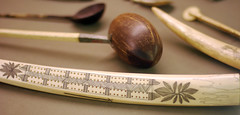
So what does this mean for those of us who work in museums/zoos/historical societies? It seems such an elementary idea, but basic labeling is important. How else does a visitor put things in context, understand the significance of the object, or find her way to the loo?
This made me think of the New York Historical Society. I posted some pictures I took there on my Flickr page (isn't this shameless self-promotion) and someone commented that she too enjoyed the museum but was frustrated by the lack of labels. I'd noticed the same thing when I was there. Here's a photo I took but I can only guess what some of these things are. There were no labels. It would have been helpful to even have something basic like "Sewing Tools."

So what does this mean for those of us who work in museums/zoos/historical societies? It seems such an elementary idea, but basic labeling is important. How else does a visitor put things in context, understand the significance of the object, or find her way to the loo?
Labels:
exhibits,
National Zoo,
New York Historical Society
Monday, March 24, 2008
Nationalism, racism or a time that tried men's souls?
Here's a picture from the MAMAS collection that Kathleen ran across today:

Unpleasant, but typical of war photography, right?
Now here's the picture with the caption scanned in:
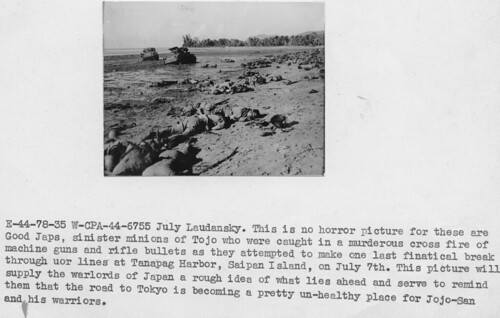
The caption reads, "This is no horror picture for these are Good Japs, sinister minions of Tojo who were caught in a murderous cross fire of machine guns and rifle bullets as they attempted to make one last [fanatical] break through [our] lines at Tanapag Harbor, Saipan Island, on July 7th. This picture will supply the warlords of Japan a rough idea of what lies ahead and serve to remind them that the road to Tokyo is becoming a pretty un-healthy place for Tojo-san and his warriors." W-CPA-44-6755 July Laudansky. 10/1/1944.
As a policy, we use the caption that the picture comes with, although we'll add additional information in brackets if necessary. This caption? It's unpleasant, but it's probably not propaganda as it was never meant to be seen except by the Museum staff who received it. Unfortunately Mr. Laudansky was almost certainly on Saipan taking photographs when these Japanese soldiers attacked (to the last man), so I think we can understand this caption as an expression of something more than either nationalism or racism too. I'd like to hope that we as a society have moved beyond some things, but if I was in Laudansky's shoes, I have no idea what I'd write. I know I'd have been terrified though.
Although in our numbering series for the Museum & Medical Arts Service, I think this photograph is a re-photograph of by MAMAS staff of Luadansky's picture for the Central Pacific Area Signal Corps group.

Unpleasant, but typical of war photography, right?
Now here's the picture with the caption scanned in:

The caption reads, "This is no horror picture for these are Good Japs, sinister minions of Tojo who were caught in a murderous cross fire of machine guns and rifle bullets as they attempted to make one last [fanatical] break through [our] lines at Tanapag Harbor, Saipan Island, on July 7th. This picture will supply the warlords of Japan a rough idea of what lies ahead and serve to remind them that the road to Tokyo is becoming a pretty un-healthy place for Tojo-san and his warriors." W-CPA-44-6755 July Laudansky. 10/1/1944.
As a policy, we use the caption that the picture comes with, although we'll add additional information in brackets if necessary. This caption? It's unpleasant, but it's probably not propaganda as it was never meant to be seen except by the Museum staff who received it. Unfortunately Mr. Laudansky was almost certainly on Saipan taking photographs when these Japanese soldiers attacked (to the last man), so I think we can understand this caption as an expression of something more than either nationalism or racism too. I'd like to hope that we as a society have moved beyond some things, but if I was in Laudansky's shoes, I have no idea what I'd write. I know I'd have been terrified though.
Although in our numbering series for the Museum & Medical Arts Service, I think this photograph is a re-photograph of by MAMAS staff of Luadansky's picture for the Central Pacific Area Signal Corps group.
Blogging and Museums
As you can tell, we're making this up as we go along, but our colleagues at Medical Museion @ University of Copenhagen have had their blog Biomedicine on Display up for a while and they've got a post up on Museums and Blogging that's worth looking at.
March of Dimes Archives
I picked up a piece of polio history the other day. This printing plate for a comic strip on a fundraising campaign.
I haven't printed it yet although we're trying, but flopping and inverting the picture lets you see it:

When we get it printed, a scan will be available from the Museum. In the meantime, it sparked a letter from the March of Dimes archivist which included this information on their archives. David's given his permission for me to repost the information.
March of Dimes Archives
The March of Dimes Archives is the official repository of non-current records of the March of Dimes. The mission of the Archives is to identify, acquire, preserve, and provide access to records documenting the history of the March of Dimes. The records consist of published and unpublished information in a variety of media created, received, and maintained by the March of Dimes and its predecessor (The National Foundation for Infantile Paralysis) in the conduct of business. Our collections include correspondence and other textual holdings, photography, film and videotape, electronic records, medical artifacts, posters, and memorabilia. The March of Dimes archivist oversees the proper organization and storage of its collections and provides both staff and the general public with information about its holdings.
Our archival collections document the history and achievements of one of the most successful voluntary health organizations in history. Highlights include the letters of Franklin Roosevelt and Basil O’Connor (first president of the National Foundation); the medical program to eradicate polio and the Salk vaccine field trial of 1954; fund-raising events such as the Mothers March, Waldorf-Astoria fashion shows, and WalkAmerica; the National Foundation Expanded Program (1958) that launched birth defects prevention as a mission objective; the career of Virginia Apgar, creator of the Apgar Score for evaluating newborns; perinatal health initiatives, including Toward Improving the Outcome of Pregnancy, a plan for the regional development of maternal and perinatal health services. Our archival resources are used by March of Dimes staff at the national office and chapters and by researchers from all walks of life who study, publish, and produce films and exhibits on epidemic disease, the history of medicine and public health, vaccines and vaccination, entertainment and political celebrities, volunteers and volunteerism, American popular culture, women’s history, disability studies, and much more.
March of Dimes archival collections include:
• Salk and Sabin Polio Vaccine Records
• Medical Program Records
• Fund Raising Records
• Film, Video, and Photography Collections
• March of Dimes Publications
• Chapter Organization and Activities Records
• Salk Institute for Biological Studies Records
• Basil O’Connor Papers
• Virginia Apgar Papers
Need assistance with historical questions? For information, please contact:
David W. Rose, Archivist
March of Dimes
1275 Mamaroneck Avenue
White Plains, NY 10605
914-997-4221
drose AT marchofdimes.com
You can also see the polio pictures we do have in the Museum, and we've got the film, Born in the White House, about the March of Dimes.

I haven't printed it yet although we're trying, but flopping and inverting the picture lets you see it:

When we get it printed, a scan will be available from the Museum. In the meantime, it sparked a letter from the March of Dimes archivist which included this information on their archives. David's given his permission for me to repost the information.
March of Dimes Archives
The March of Dimes Archives is the official repository of non-current records of the March of Dimes. The mission of the Archives is to identify, acquire, preserve, and provide access to records documenting the history of the March of Dimes. The records consist of published and unpublished information in a variety of media created, received, and maintained by the March of Dimes and its predecessor (The National Foundation for Infantile Paralysis) in the conduct of business. Our collections include correspondence and other textual holdings, photography, film and videotape, electronic records, medical artifacts, posters, and memorabilia. The March of Dimes archivist oversees the proper organization and storage of its collections and provides both staff and the general public with information about its holdings.
Our archival collections document the history and achievements of one of the most successful voluntary health organizations in history. Highlights include the letters of Franklin Roosevelt and Basil O’Connor (first president of the National Foundation); the medical program to eradicate polio and the Salk vaccine field trial of 1954; fund-raising events such as the Mothers March, Waldorf-Astoria fashion shows, and WalkAmerica; the National Foundation Expanded Program (1958) that launched birth defects prevention as a mission objective; the career of Virginia Apgar, creator of the Apgar Score for evaluating newborns; perinatal health initiatives, including Toward Improving the Outcome of Pregnancy, a plan for the regional development of maternal and perinatal health services. Our archival resources are used by March of Dimes staff at the national office and chapters and by researchers from all walks of life who study, publish, and produce films and exhibits on epidemic disease, the history of medicine and public health, vaccines and vaccination, entertainment and political celebrities, volunteers and volunteerism, American popular culture, women’s history, disability studies, and much more.
March of Dimes archival collections include:
• Salk and Sabin Polio Vaccine Records
• Medical Program Records
• Fund Raising Records
• Film, Video, and Photography Collections
• March of Dimes Publications
• Chapter Organization and Activities Records
• Salk Institute for Biological Studies Records
• Basil O’Connor Papers
• Virginia Apgar Papers
Need assistance with historical questions? For information, please contact:
David W. Rose, Archivist
March of Dimes
1275 Mamaroneck Avenue
White Plains, NY 10605
914-997-4221
drose AT marchofdimes.com
You can also see the polio pictures we do have in the Museum, and we've got the film, Born in the White House, about the March of Dimes.
Sunday, March 23, 2008
Telemedicine of the Third Kind
This article talks about another type of telemedicine - one in which patients load their symptoms and treatment into an online database to aid research, and possibly themselves.
"Practicing Patients," by THOMAS GOETZ, NY Times Magazine March 23, 2008.
PatientsLikeMe, an Internet start-up, creates information-rich communities for the chronically ill. Is it the next step forward in medical science — or just a MySpace for the afflicted?
"Practicing Patients," by THOMAS GOETZ, NY Times Magazine March 23, 2008.
PatientsLikeMe, an Internet start-up, creates information-rich communities for the chronically ill. Is it the next step forward in medical science — or just a MySpace for the afflicted?
Atomic veterans
We're asked fairly regularly for material relating to nuclear explosions, mostly photographs, of either Hiroshima or Nagasaki, or later tests. An article about Canadian veterans and their attempt to get benefits can be seen at "Troops exposed in nukes testing fight for aid," By Barry Brown, Washington Times March 23, 2008.
Another article related to forensic ID exhibit
Here's another article about another country and cultures take on identifying its dead soldiers - "Anonymous Korean War Dead Still Await Trip Home," By CHOE SANG-HUN, NY Times March 23, 2008.
Known as the “enemy cemetery” in South Korea, it contains the remains of communist fighters or infiltrators North Korea has not reclaimed.
I believe our exhibit on identifying US war dead is planned to open in early summer although I'm not involved in it.
Known as the “enemy cemetery” in South Korea, it contains the remains of communist fighters or infiltrators North Korea has not reclaimed.
I believe our exhibit on identifying US war dead is planned to open in early summer although I'm not involved in it.
Saturday, March 22, 2008
See Inside Beta People
Medgadget linked to it, and since our Museum features actual anatomical specimens, I thought maybe our readers would be interested in this new site BodyMaps: A Human Atlas. The site sometimes took a moment to resolve on the screen after selecting a different system, but that doesn't put a dent though in its coolness factor. Enjoy.
Subscribe to:
Posts (Atom)